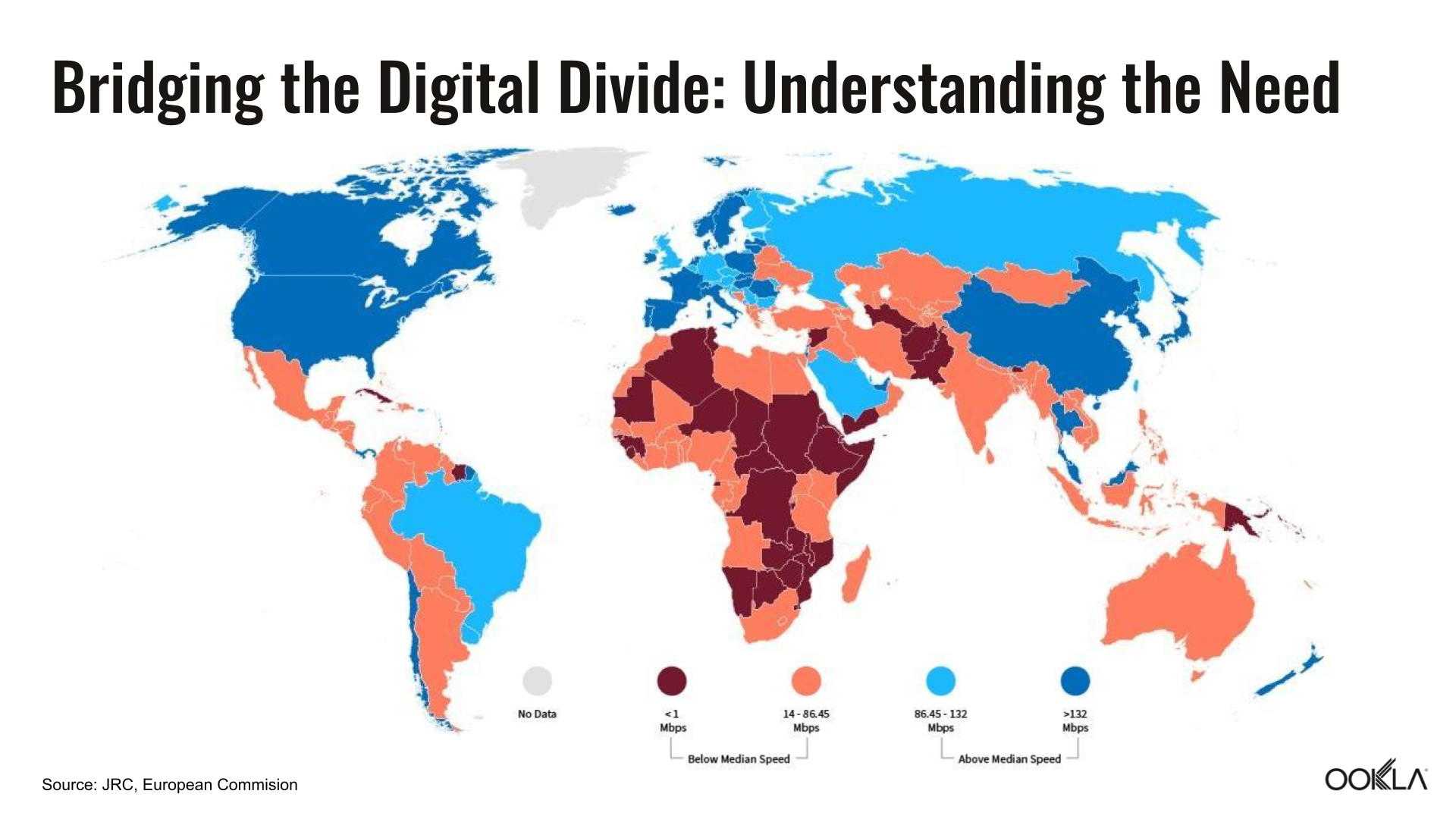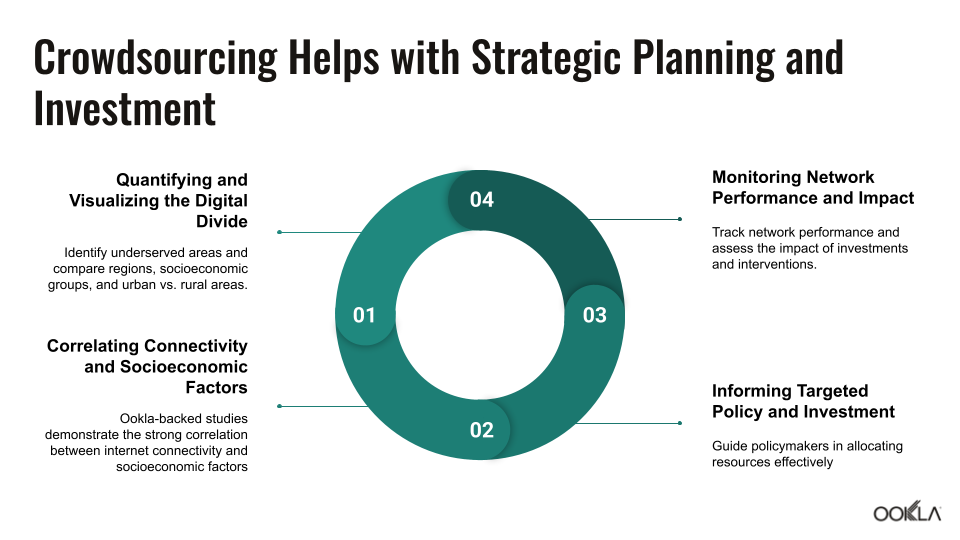Digital connectivity has become essential for modern life, with access to high-speed internet now allowing people to work remotely, access education, receive healthcare services, and participate in online commerce and banking. Yet a stark digital divide persists: while 40% of urban centers globally enjoy download speeds exceeding 100 Mbps (sufficient for most demanding online activities including HD video streaming and remote work), rural communities across the world — including in Africa, Central and Southern Asia — often struggle with slow connectivity or none at all. These disparities can create profound differences in opportunity, limiting the potential for many communities worldwide.
To effectively address connectivity gaps, regulators and policymakers need granular, accurate data on real-world network performance, and that’s where data from Ookla® can help. Crowdsourced data from Ookla’s Speedtest® provides crucial insights into actual user experiences, helps identify underserved areas, tracks improvements, and holds service providers accountable for deployment promises.
In this article, we’ll examine the current state of global connectivity disparities, explore how the digital divide affects education, healthcare, and economic opportunities in underserved areas, and show how Egypt’s Decent Life Initiative is using data-driven approaches to transform rural connectivity.
For a deeper look into these topics, including case studies and methodological insights from Ookla and the National Telecom Regulatory Authority (NTRA) of Egypt, watch our full webinar.
The State of Global Digital Connectivity
Effective solutions start with an accurate diagnosis. Before meaningful progress can be made in bridging the digital divide, stakeholders need precise data showing where connectivity gaps are widest and which communities are most affected. Without detailed mapping of these disparities, stakeholders risk directing investments to the wrong areas and missing chances to help those most in need.
A study by the European Commission’s Joint Research Center, conducted in partnership with Ookla, revealed several key findings about global connectivity disparities:
- Many countries in Africa lag significantly behind, with some regions experiencing median download speeds below 3 Mbps.
- Broadband speeds vary dramatically between and within regions, with 40% of urban centers enjoying speeds over 100 Mbps while others struggle with basic connectivity.
- A strong correlation exists between connectivity and economic development, with high-income countries enjoying significantly better broadband speeds.
- In many countries in Africa and other developing regions, mobile networks are more widespread and better performing than fixed broadband networks.
These findings highlight the complex nature of the digital divide and the need for targeted approaches to address connectivity challenges in different regions. By mapping end-user speeds and coverage differences with precision, stakeholders can develop more effective interventions tailored to specific geographic and socioeconomic situations.
The Real Impact of the Digital Divide
Connectivity gaps aren’t just data points on a map – they represent real barriers that affect people’s everyday lives. When communities lack reliable internet access, they face serious disadvantages across multiple areas of life, as seen in Sub-Saharan Africa, where GSMA reports two-thirds of the population (710 million people) do not currently use mobile internet despite living within the footprint of a mobile broadband network. These impacts include:
- Limited access to information directly affects civic participation, with disconnected communities unable to access government services, agricultural guidance, and essential public health information.
- Educational inequality deepens when rural students cannot access digital learning resources and research materials or utilize remote learning options available to their urban counterparts.
- Healthcare outcomes suffer as communities without reliable connectivity cannot benefit from telemedicine, remote diagnostics, or timely access to medical specialists.
- Economic opportunities vanish when rural residents cannot participate in e-commerce, access online job markets, or utilize digital financial services
Addressing connectivity problems requires understanding not just where internet access is lacking, but how that absence affects real people in these communities. With this understanding, stakeholders can develop more effective strategies that prioritize the most impactful investments.
Leveraging Crowdsourced Data for Better Connectivity
When making connectivity decisions, actual user experiences matter more than theoretical coverage maps. Regulators need to know where people are truly experiencing poor or great service, not just where internet providers claim to provide coverage. Ookla’s crowdsourced data reveals these real-world experiences, helping stakeholders make better decisions through several practical applications:
- Creating precision maps of connectivity disparities by visualizing actual speeds geographically rather than relying on operator-reported coverage claims.
- Identifying socioeconomic impacts through targeted research, such as the World Bank’s use of Ookla data to discover that 30% of areas near Brazilian educational facilities had inadequate speeds for effective e-learning.
- Guiding evidence-based policy decisions, as demonstrated in the OECD’s analysis, revealed that rural fixed broadband speeds averaged 31% below national averages even in developed countries.
- Establishing accountability frameworks, exemplified by South Carolina’s use of Ookla data to track rural-urban connectivity gaps and verify that providers delivered promised service improvements.
The examples from Brazil, OECD countries, and South Carolina demonstrate how empirical, user-generated data provides crucial insights that theoretical coverage models simply cannot offer. With such a granular understanding of actual network performance, regulators can target investments more precisely, measure progress accurately, and hold providers accountable for delivering on any promised improvements.
Case Study: Egypt’s Decent Life Initiative
Egypt’s ambitious Decent Life Project is a comprehensive national development program launched to improve the quality of life in rural areas, with telecommunications infrastructure as a key component. Launched in 2019, it demonstrates how data-driven planning, strategic investment, and public-private collaboration can transform rural connectivity at scale. This nationwide program tackles both coverage and quality issues in some of the country’s most underserved communities:
- A comprehensive approach targeting 4,500 villages and directly impacting over 58 million Egyptians through improved infrastructure and services
- Collaborative implementation involving more than 20 ministries, 23 civil society organizations, and numerous volunteers to address connectivity alongside other development needs
- Strategic two-pillar telecommunications strategy focusing on mobile network expansion (establishing 1,096 new stations) and fiber optic deployment (targeting 2.8 million buildings)
- Measurable improvements in download speeds across targeted governorates, documented via before-and-after performance testing using Ookla data
- Innovative funding model combining government funding resources with private operator investments to share costs and accelerate deployment
With 80% of the first phase complete and plans to reach 99% mobile coverage by 2025, Egypt’s Decent Life Project demonstrates how targeted interventions can dramatically reduce rural-urban connectivity disparities. Egypt’s approach also underscores the power of coordinated action across government agencies, private sector partners, and civil society organizations.
Best Practices for Addressing the Digital Divide
Successful digital divide initiatives like Egypt’s Decent Life Project and many others revealed a crucial insight: technical solutions alone cannot solve connectivity challenges when underlying economic, regulatory, and social barriers remain unaddressed.
Indeed, meaningful change occurs when comprehensive strategies align policy, funding, and technology toward clearly defined connectivity goals. Across initiatives aimed at narrowing the digital divide, several approaches consistently deliver positive results:
- Data-centric planning that uses granular performance metrics to identify specific underserved areas rather than relying on broad regional generalizations
- Technology diversity that combines mobile, fixed, and alternative technologies based on local geography, population density, and economic conditions
- Collaborative funding frameworks that blend public resources with private investment to distribute costs and create appropriate incentives
- Focus on outcomes rather than specific technologies, allowing solutions to adapt to local contexts and evolving capabilities
- Parallel investment in digital literacy and relevant content to ensure infrastructure investments translate into actual adoption and usage
- Continuous performance monitoring to maintain accountability, document improvements, and adjust strategies based on measured results
Practical experience from successful initiatives around the world shows that these elements form not just a theoretical framework but a proven roadmap for accelerating connectivity improvements. By combining data-driven planning, appropriate technology choices, innovative funding, and continuous performance monitoring, countries can make rapid progress even in challenging environments.
Conclusion
Bridging the digital divide requires a comprehensive understanding of both coverage and usage gaps, strategic investment in infrastructure, and ongoing assessment of performance improvements. As demonstrated by Egypt’s Decent Life Project, crowdsourced data plays a critical role in guiding these efforts and measuring their impact.
When regulators leverage accurate, real-time performance data, they can more effectively address connectivity challenges and ensure digital resources are accessible to all communities. The result is not just improved network statistics but meaningful improvements in education, healthcare, economic opportunity, and quality of life.

For a more detailed examination of how regulators are using crowdsourced data to improve rural connectivity, including additional case studies and methodological insights, check out our recent webinar, “How Regulators Use Crowdsourced Data to Improve Connectivity in Underserved Rural Communities.”
Ookla retains ownership of this article including all of the intellectual property rights, data, content graphs and analysis. This article may not be quoted, reproduced, distributed or published for any commercial purpose without prior consent. Members of the press and others using the findings in this article for non-commercial purposes are welcome to publicly share and link to report information with attribution to Ookla.



